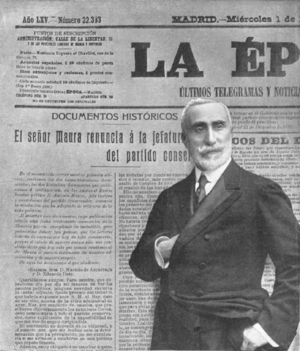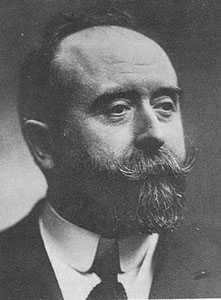Conservative Party (Spain) facts for kids
Quick facts for kids
Liberal Conservative Party
Partido Liberal-Conservador
|
|
|---|---|
| Leaders | Antonio Cánovas Arsenio Martínez-Campos Francisco Silvela Antonio Maura Eduardo Dato José Sánchez-Guerra |
| Founded | 1876 |
| Dissolved | 1931 |
| Preceded by | Moderate Party Liberal Union |
| Merged into | Popular Party |
| Ideology | Monarchism Centralization Liberal conservatism |
| Political position | Centre-right |
The Liberal Conservative Party (in Spanish, Partido Liberal-Conservador), also known simply as the Conservative Party, was an important political group in Spain. It was started in 1876 by Antonio Cánovas del Castillo. This party played a big role in Spanish politics for many years.
Contents
History of the Conservative Party
How the Party Started
The Liberal Conservative Party was founded by Antonio Cánovas del Castillo between 1874 and 1876. He created it at the request of Alfonso XII of Spain, who became king after the First Spanish Republic ended. The party was called "liberal" because it supported the system of government set out in the 1876 Constitution. It was called "conservative" because it wanted to keep many traditional ideas in Spain.
Many of its first members came from older political groups. These included parts of the former Liberal Union and the Moderate Party. Cánovas del Castillo was a very powerful figure in Spanish politics for a long time.
In 1885, the Conservative Party made an agreement called the Pact of El Pardo with the Liberal Party. This agreement meant that the two parties would take turns being in power. This system was called turno. It was meant to keep more radical groups, like socialists or anarchists, from gaining power. Local leaders, known as caciques, helped make sure this system worked across Spain.
After Cánovas del Castillo was sadly killed in 1897, Francisco Silvela took over as the party's leader.
Antonio Maura's Leadership (1905–1913)
After Francisco Silvela passed away in 1905, the Conservative Party needed a new strong leader. Antonio Maura became the new head of the party. He had actually been part of the Liberal Party before joining the Conservatives.
Maura became the head of the government several times. His most important period was from 1907 to 1909. During this time, he introduced many new laws. These included laws about elections, strikes, and Sunday rest. He also helped create the National Institute of Social Security (INP). This was a big step in helping people with social welfare. He also worked to make the Spanish Navy more modern.
Maura also tried to improve Spain's relationships with France and Great Britain. However, his time in power also saw some serious public order problems. One major event was the Tragic Week (Spain) in Barcelona in 1909. This led to a lot of public anger against Maura. He eventually had to leave the government in October 1909. In 1913, he stepped down from leading the party.
Eduardo Dato's Time (1913–1921)
In 1913, Eduardo Dato became the leader of the Conservative Party. His leadership caused a split within the party. Some members supported Maura (called Maurists), and others supported Dato (called Dadatists).
Dato also became the head of the government. In 1917, he had to deal with a big general strike. He worked on social reforms, like creating the Ministry of Labour. He also introduced the Law on Accidents at Work. Dato was sadly killed in Madrid in 1921 while he was still leading the government.
The Party's Final Years (1923–1931)
In September 1923, General Miguel Primo de Rivera took control of Spain. This period was called the Dictatorship. During this time, the Conservative Party and its leaders were not involved in politics.
The party returned to government briefly in 1930. This was under Admiral Juan Bautista Aznar-Cabañas. Juan de la Cierva y Peñafiel became the leader of the Conservatives during this time. Many of the party's earlier leaders, like Silvela, Maura, and Dato, had passed away.
In April 1931, there were local elections in Spain. The results showed that the Liberal and Conservative parties did not have much support from the people. On April 14, 1931, the Second Republic was declared in Spain. The Conservative Party disappeared shortly after this.
Party Leaders
- 1876–1897 Antonio Cánovas del Castillo
- 1897–1905 Francisco Silvela
- 1905–1913 Antonio Maura
- 1913–1921 Eduardo Dato e Iradier
- 1921–1923 No official leader
- 1923–1930 No official leader (during the dictatorship)
- 1930–1931 Juan de la Cierva y Peñafiel
See also
 In Spanish: Partido Liberal-Conservador para niños
In Spanish: Partido Liberal-Conservador para niños
- Liberal Party (Spain, 1880)
- Political System of the Restoration (Spain)



